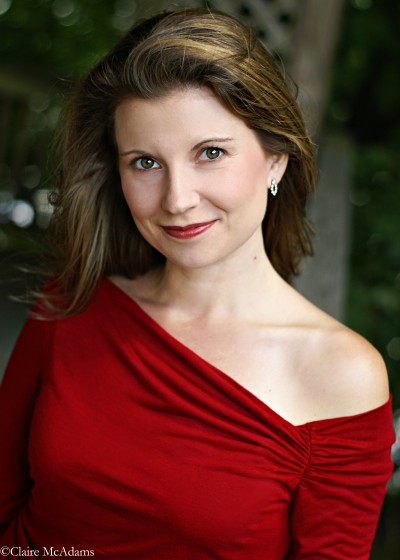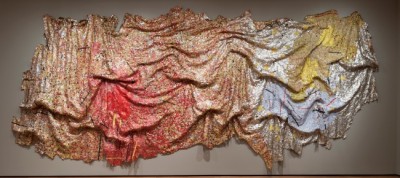
Miami group uses art to refresh art song
Mix a display of sculptures by a major West African artist with an art song recital, and what do you get?
Something, perhaps, that’s half art exhibit and half concert, or maybe something that glides between the two worlds ably enough that an audience member would be unaware of any obvious joins between the two.
Soon, Miami arts fans will find out for themselves, when the fledgling IlluminArts group presents a concert Sept. 12 at the Bass Museum of Art on Miami Beach in a program inspired by the works of El Anatsui, which have been on display at the museum since April and will depart at the end of next month. The exhibit, “Gravity and Grace: Monumental Works by El Anatsui,” was originally organized by the Akron Art Museum with the help of a Knight Foundation grant.
IlluminArts, one of the 75 finalists for a Knight Arts Challenge grant to be awarded in December, will present music suggested by the art, almost all of it contemporary music, with the sole exception of Ravel’s Chansons madécasses, a song cycle from 1925 for mezzo-soprano, flute, cello and piano.
Singing this exquisite trio of songs will be mezzo Amanda Crider, familiar to area audiences for her work with groups such as Seraphic Fire and the Master Chorale of South Florida. Crider, who founded IlluminArts and then invited soprano and arts administrator Susan Hellman and pianist Anna Fateeva to join her, said she first had to deal with the conventional wisdom in classical circles that the art song recital is dead — or at the very least, on a morphine drip in the cultural hospice.
“I personally love art song, and I participated a few years ago in Marilyn Horne’s ‘The Song Continues’ at Carnegie Hall,” she said, referring to Horne, one of the great mezzos of an older generation, who in her retirement from the stage has become a tireless educator of young singers. Horne’s annual The Song Continues is a series of master classes and coaching sessions for promising singers.
“Part of that workshop was actually to have round-table discussions about how we can bring art song to our own communities … And I was trying to think how I could bring it to Miami, and make it relevant. Because I don’t think that people will continue to go to a concert hall, and get a program with (song) translations that they’re sitting there and reading, and following along,” she said. “I just don’t think modern audiences have the attention span for that, and honestly, I went to an art song recital a few years ago in Washington, D.C., and I was bored. And I love art song.”
Crider took a cue from her work as a young artist at the Glimmerglass Opera in upstate New York, a company that requires its singers to speak to the audience at their recitals.
“At first, it’s terrifying, but then it’s liberating, because you make a connection with your audience, and you get to tell them what strikes you about the music, and what they might want to listen for,” she said. “So I make that a priority at these events, where we talk to the audience. If the song is in a different language, I give them a synopsis or read them part of the poetry, because the poetry is what really brings the music to life. I’m really trying to break down the old format and present it so it’s relevant.”
‘Gravity and Grace,’ (2010) by El Anatsui. Photo by Andrew McAllister / Akron Art Museum
The Sept. 12 concert, which is set for 7 p.m. at the Bass, will be very untraditional in that attendees will walk through the exhibit as the concert is presented. The concert will begin downstairs with an introduction that will include percussionist Michael Zell playing American composer Paul Smadbeck’s Rhythm Song, considered a modern classic for the marimba. The audience then will walk upstairs to the first piece of art, and also hear an unaccompanied solo song for soprano, Gravity, by the British composer and conductor Oliver Knussen.
Each stop in front of the artworks will take about five to ten minutes, and will feature, in addition to the Ravel songs, works by American composer Gene Koshinski (Summer Stars, for mezzo and percussion), Russian composer Ksenia Prasolova (View Into the Stream, for soprano and cello) and two works by the Ghanaian-American composer Fred Onovwerosuoke (Ne Nkansu and Ngulu, for soprano and marimba). The final work, commissioned for this concert, will be a piece for mezzo and electronics called A Million Pieces of Your Voice, by the American composer Jenny Olivia Johnson.
Joining Crider in this concert along with Fateeva, Hellman and Zell will be flutist Elissa Lakofsky and cellist Rosanna Butterfield, along with dancer JoAnna Ursal, who will be on hand for the closing work by Johnson.
“The way it’s laid out, it takes up the entire top floor of the museum,” Crider said of the exhibit. “We will talk to the audience and tell them how it’s going to work, and speak to them about the pieces in between, when we find it necessary, if we want to transition just with the music … I don’t mind if people are listening to the music and looking at the art, and not paying attention to the performance necessarily, but really experiencing both things together.”
Crider said programming a concert almost entirely of contemporary music was not deliberate, but evolved out of thinking about what kind of music would go best with the displays, visiting the exhibit, and discussing it with its curator, Jose Carlos Diaz. She was particularly impressed by Anatsui’s use of his whole community to help create the artworks.
“When you see them in person, you’ll be amazed at the detail and the intricacy of the work that goes into these pieces. It’s incredible,” she said.
The music by Onovwerosuoke, whose parents were Nigerians and who also lived in that nation before coming to the United States, therefore seemed “a really good fit” for an exhibit of works by Anatsui, a resident of Nigeria who like FredO (as he is familiarly known) is a native of Ghana.
This will be IlluminArts’s second public performance, its first having taken place in May at the Bakehouse Art Complex.
“I had put out all my reach into the community, and I thought, ‘Gosh, I hope people come.’ And it was packed. And people kept coming, and I thought, ‘Oh, my gosh, it’s working! People are coming to see this,’” Crider said. “And they responded so well to it. It was a very young audience; people were tweeting and taking videos during the concert, which I’m totally fine with. I want young people to come to these events, and be excited about the art and the music.”
IlluminArts is scheduled to return to the Bakehouse for two more concerts next year, including one on Valentine’s Day. “The Bakehouse was super-receptive to what we were doing, and said we can be there as much as we want. We may even start a salon series there that is more about the music than the art, though we’ll always do the combination events,” she said.
Ultimately, IlluminArts would love to have a series of five performances a season. Crider has talked to the Locust Projects about doing a show there, “and I’m always open to researching new galleries and museums to see where we might be able to do a collaboration.”
The group has asked for a grant of $60,000 over two years from the Knight Foundation, and is lining up matching funds in case the grant comes through.
“I’m going to try to do crowdfunding for part of it, and I’m also looking at different grant opportunities and individual contributions. I feel blessed to have some support from people already in the community, and if I get the grant, I can’t wait to tell them,” she said.
Doing IlluminArts has been good for restoring Crider’s faith in the viability of the art song recital, even if it’s done in a way far from the old standard of a bejeweled singer standing in the rim of a big, black concert grand.
“Since I started IlluminArts, I’ve had so many composers write to me and say, ‘I have some art songs. Can I send them to you to see if you want to program it on an upcoming event?’ So it just shows me that composers are still drawn to this art form, and it’s really important to me to know that this art form is evolving, and it’s going to exist.”
Just as important is what the project is able to do for Crider’s adopted city. A Northeasterner who’s lived in Miami for six years, she created IlluminArts with Miami in mind, thinking in particular of its vibrant visual arts scene.
“I was really thinking specifically about the community here, and how I could build appreciation for it in Miami,” she said. “There are different art song festivals in different cities around the country … They have a different audience, a different community that they have to tailor their events to. I think Miami is a very specific community, and there’s so much that can be done here culturally.
“And I think it’s an exciting place to be in that way, because you can tie art forms together, and it can be a new way to present things. And Miami is receptive to those kinds of things, because it’s a new, young city.”
The Sept. 12 IlluminArts concert, which starts at 7 p.m., is free with an $8 admission to the Bass Museum of Art, 2100 Collins Ave., Miami Beach. For more information, call 786-565-2180 or send an email to [email protected].
Recent Content
-
Artsarticle ·
-
Artsarticle ·
-
Artsarticle ·


